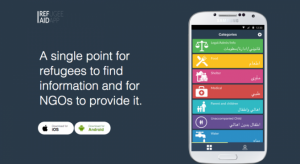What aid and support can ICT provide to refugees?
Migration 6 June 2016Technology is often referred as a support or a potential solution to many situations that impact greatly refugees’ lives. But what are they exactly?
In 2015, the number of refugees, asylum seekers, and internally displaced people worldwide exceeded 50 million – the highest number reported since World War II. Europe is witnessing the largest influx of refugees since the 40’s too, the majority of them coming from Afghanistan and Syria, fleeing violent conflict and war torn communities.
Refugees run toward neighbouring countries where they often face extreme poverty and limited opportunities to rebuild their lives. In many cases, they are educated and they used to live in conditions that are far better than those facing once in Jordan, Turkey or some EU member state.
Technology is often referred as a support or a potential solution to many situations that impact greatly refugees’ lives. But what are they exactly? Let us see together some of them.
In refugees camps or shelters
Nowadays, satellite imagery and Geographical Information Systems (GIS) are used to plan, build, and manage refugee camps and organise humanitarian interventions. The UN and international organisations alike use these maps to identify migration patterns inside the camp and determine how to allocate resources efficiently.
Additionally, these same maps facilitate interoperability among international relief organisations on the ground to avoid duplicating efforts. This is the case, for example, of the Al-Zaatari Refugee Camp located in Mafraq, Jordan.
Mobile phones
According to the results of a survey conducted among Syrian refugees by Penn State University and the Office of the United Nations High Commissioner for Refugees (UNHCR), 86% of the youth that were interviewed indicated that they own a mobile device, and more than 50% indicated they used the Internet either once or multiple times per day. Furthermore, respondents indicated that they use mobile phones to access the news, social media, and stay in touch with family members in other settlements or with those who remained in Syria. Computer and tablets are not common among refugees, and are used when available in common spaces.
Mobile phones have allowed refugees to contact the coastal guard or other help to communicate the position of their boat in distress. They are a tool to get in touch with the smugglers that are facilitating a certain path. Phones can also be dangerous, when they represent the way traffickers use to strengthen or reinforce their connection with a victim and/or monitor their movements. In many cases, mobile phones have become a necessity, as it is the one tool that helps refugees to avoid isolation and maintain a contact with their loved ones.
Many organisations have understood the importance of phones and set up Wi-Fi hotspots and points where to recharge the battery in shelters or camps of first arrival.
Apps
 Once understood the importance of mobile phones for refugees, several apps have been developed to support them. One of the most innovative is RefAid – refugee aid app. The app aims at being a single point for refugees to find information on services available and for NGOs or other organisations to provide it. The app provides to the user geo-localised information on a specific aid available (e.g. shelter, food, counselling). It was launched in the UK but it is now available in several countries across the EU.
Once understood the importance of mobile phones for refugees, several apps have been developed to support them. One of the most innovative is RefAid – refugee aid app. The app aims at being a single point for refugees to find information on services available and for NGOs or other organisations to provide it. The app provides to the user geo-localised information on a specific aid available (e.g. shelter, food, counselling). It was launched in the UK but it is now available in several countries across the EU.
A website called appsforrefugees.com collects the most interesting and creative apps developed to provide aid and support.
Possibilities to be explored: ICT to support education
Several challenges need to be addressed when thinking about an efficient education system for refugee children. The second issue has to do with teachers. It is estimated that there is a need to train several thousands of teachers, and again, the challenge here is both scale and time, particularly because of geographic dispersion. Third, there is the issue of facilities. It is important to differentiate the types of refugees and their locations. Finally, there is the issue of the curriculum.
Technology can provide effective educational methods that can be used not only to train the teachers more quickly, but also to reach children directly, providing them with catch-up study methods. It can also serve as a self-study method where schools may not be available. It could also be used to train the teachers as well as create communities of learning that cut across international borders.


